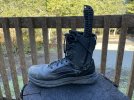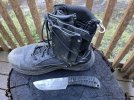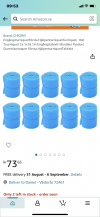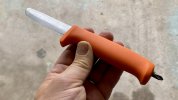The best rescue tool is a Platinum MasterCard with no pre-set limit...
The BMW toolkit.
The BladeForums.com 2024 Traditional Knife is available! Price is $250 ea (shipped within CONUS).
Order here: https://www.bladeforums.com/help/2024-traditional/
The best rescue tool is a Platinum MasterCard with no pre-set limit...
Thanks, great postI have been through a lot of different knives to use in a pinch for rescue purposes at work. None of them are replacements for the professional tools we carry, but can be used quickly if I don't have something else handy.
The Gerber Hinderer Rescue was one of the earliest and was decent, but compromised a lot for use as a regular knife. The unsharpened tip and bulkiness weren't my favorite and the use of steel for the glass breaker as opposed to carbide kinda limited the number of times you could use it. Tempered glass doesn't need a lot of force, just a small tip to generate high pressure. The steel point can round out over time and greatly increase the force needed to break tempered glass. I believe it has been discontinued but they still make the derivative Combat Life Saver model in tactical black instead of red, and a sharpened point on the blade.
The Kershaw Funxion EMT also got pocket time at work for a while and is closer to the CLS model I listed than the Hinderer Rescue. A couple of the nice improvements were a flipper deployment for easier one handed opening, and a carabiner clip. Though honestly I no longer prefer spring assist models. The carabiner clip on it was also nice that I could clip it to my fire gear, and not have to dig inside to my pants pocket to get it, and the clip also served as a safety to prevent blade deployment. The carabiner spring eventually wore out, and I upgraded my gear, but I still have this in one of my vehicles just in case I am out and about with an empty pocket. The glass breaker is carbide and held up to better use. The cutting hook on this knife was used several times to open victims clothing for treatment, especially shirts to get defibrillator pads on, and I find a safe cutting hook or sheepsfoot in an emergency as a very important feature if I have to cut close to someone.
The best all around, if somewhat heavy knife I found for rescue purposes was the Benchmade Outlast which is no longer in production either. It was a manual "Option Lock" (Axis lock) specially designed to offer two independently useful blades. A standard drop point in S30V for general use, and a fully serrated flat tipped blade in 3V for cutting rope/rough materials and emergency prying tasks. It also had a carbide breaker and 440C hook. That hook also got a lot of use. The Tactical Triage is probably closest to it, but only has one combo edge blade leading to some compromises in usefulness, though it is lighter, thinner and cheaper.
Honestly though, I think the most practical setup is a Raptor Rescue folding shear set paired with a knife you already trust. It has heavy duty shears plus a cutting hook offering two options for cutting around a victim, ring cutter or other soft metal cutter on the back side of the hinge, oxygen wrench, carbide glass breaker. They come with a pocket clip and can be carried opposite your main knife, or in a cargo pocket if you carry something else (light etc.) on your opposite side. I happily pair this with anything from an Ontario Rat in D2 to a Spyderco Gayle Bradley 2, and feel ready for any reasonable scenario.
I tend to keep at least one rescue designed knife in a locking cubby near my driving position in any vehicle I am in, but don't always carry one on me unless I am venturing far away from my vehicle. If I am specifically looking to be prepared either the Outlast or the Raptor paired with another trusty knife and at least one flashlight are with me. I'll usually have a heavy duty Leatherman (Surge or Super Tool) somewhere handy also.
MD is restrictive on fixed blades, so I tend not to carry them unless I have a specific need envisioned. I do carry a Benchmade H20 dive knife with/near my fire gear. It is marketed as a dive knife but has a flat tip for prying, a combo edge blade on one side and cutting hook on the other. It comes in handy cutting away side impact airbags and being less likely to injure a victim in a car accident. It is N680 so pretty tough, virtually rust proof but only moderate edge holding. But as seldom as it sees use, that has not been issue so far.
I know this was originally on knives, but I would definitely add a commercial tourniquet (or 2) to your vehicle and a trusty flashlight. Get familiar with the use of the tourniquet and how to quickly apply it ahead of time.
For background, I started as a volunteer firefighter in 1997, and have been working full time career fire in a large metro area department since 2001 in a number of different assignments and ranks. I was an EMT early on, paramedic for the last 17 years or so, and also worked part time as a paramedic in an EMS only department for a bit where assistance from volunteer fire services could be delayed, so I have put my various knives/tools to work quite a bit over the years, but I won't say my experience will reflect everyone else's. A lot of firefighter just carry whatever $25-50 dollar knife they can pick up quickly and make it work. A lot of the cheaper "rescue" knives are not worth the name printed on the though.



I don’t have any tourniquets, and I note there is a large variety available. Got any tips for a non-professional? What about these, they look simple? Or are they useless?I know this was originally on knives, but I would definitely add a commercial tourniquet (or 2) to your vehicle and a trusty flashlight. Get familiar with the use of the tourniquet and how to quickly apply it ahead of time.

NiceThis is the first knife I made and I designed it to be a rescue/entry/survival knife for my job. (Forged from 1/4” 5160 to ~55-56 hrc)
View attachment 2285129View attachment 2285131
I’m a Peace Officer that works mostly in natural and rural areas - sometimes referred to as a Pine Swine or Twig Pig.So, I wanted a tough fixed blade that could do some chopping in the event I got lost/injured in the woods.
This knife has been on my boot for about 17 years now and while I use it fairly often it’s only been used in one actual rescue - I handed it to a “Good Samaritan” so he could cut through the convertible top of a car that had crashed and was partially submerged.
As it happens, it’s been used mostly for euthanasia of wild animals that have been injured beyond rehabilitation and release back into the wild, and throwing at logs.
I also carry mini trauma shears in a pocket and wouldn’t use a knife to cut clothing except as a last resort.
I tested the pointed pommel on auto glass and it goes through side windows with some effort - but expect your arm to get cut up if you aren’t wearing long sleeves while performing this operation…
Ask me how I know…

It’ll be tough.Nice
I expect I will not have a chance to practice any car glass breaking skills in the near future. Do you, and others who have experience from this activity, believe the Philips bit I press/glue fitted into the butt end of a hultafors will work to break through a side window?
View attachment 2285139
If bulk isn’t an issue, I’d recommend the C-A-T tourniquet. It’s one of two brands (can’t recall the other - but very similar style) that our Department provides and it’s very simple to use and apply to yourself. BTW - our protocol has changed recently and tourniquets are to be applied “high and tight” (eg - at the top of the bicep or top of the thigh) instead of an inch above the wound regardless of where the wound is located on the limb, as these locations apparently are much more effective and the likelihood of loosing a limb is low (unless advanced rescue will be very extended). This isn’t medical advice btw - just suggesting you look into the subject.I don’t have any tourniquets, and I note there is a large variety available. Got any tips for a non-professional? What about these, they look simple? Or are they useless?
View attachment 2285138
Talking about inertia, I have a 2D cell maglite in the glove compartment. It’s a pretty hefty chunk of a flashlight, but of course it doesn’t have a glass breaking xxx carbide tip. But could it work to get through a side window from inside the car?It’ll be tough.
That knife won’t have much inertia and I really had to swing hard to get my knife to shatter a side window, from outside the car.
I’d suggest sharpening the driver bit to a point with a file, but even then I don’t think you’d have enough wind-up room to use it to ESCAPE from your own car. I found some weird carbide window breakers online that plug into a cigarette lighter port and doubles as a dual USB port. It’s small but the sharp carbide point makes a huge difference.
Ouch. Scary.Also I just remembered that two of my partners recently responded to a fatal crash where one of the fatalities was driving a Tesla that ended up almost completely submerged in a pond. The driver was belted in and so was likely unconscious (thankfully) when he drowned, however my partners apparently had a hard time just getting to the driver through all of the AIRBAGS that were floating throughout the interior of the car. Just one more reason to always carry a folder on your person at all times imo…
From my experiences I never seen anyone use one. When I was a city fireman ages ago, (early 2000’s-2009) we all just carried regular knives. I carried a Buck 110 mostly. My stepdad, who was also my captain, carried a Buck 180, an old Gerber multitool on his belt, and a Case Sodbuster. Another guy carried a S&W SWAT knife. Everybody else had similar knives. Years and years later I was a sheriffs deputy and carried a Buck 110 and a Benchmade Griptillian. Sometimes the Benchmade would be swapped for something else, but similar. A pocket clipped one hand folder. Lots of others carried Kershaw Blurs or Leeks. There was one guy at the fire hall that had a Spyderco rescue knife and I don’t think I ever seen him use it. It just always stayed clipped to his gear.
Given my experiences in emergency services, I’m going to say that it doesn’t have to be a fixed blade. Blunted tip, yeah. Serrated? Ah, sure. I don’t think it has to be though. I don’t think handle color matters. Glass breaker tip could be handy but usually there’s other, better, things to smash windows with.
If I was to be in the market for one I’d want one of the old model Spyderco rescue knives, I say older model because I haven’t played with a newer model.
These are my observations and experiences, other peoples will vary.
They are actually pretty garbage at going through windows.Talking about inertia, I have a 2D cell maglite in the glove compartment. It’s a pretty hefty chunk of a flashlight, but of course it doesn’t have a glass breaking xxx carbide tip. But could it work to get through a side window from inside the car?
interesting!They are actually pretty garbage at going through windows.
So then I thought mabye there is a glass breaker mod for them.
I’m not in the U.S. but I have a couple of options I believe, my employer organises CPR training sessions with professionals, I could ask them to show me how to work with tourniquets, or I could check with my friend who is a firefighter captain.Breaking this up into a couple areas:
Rescue knives- time, place, purpose and training. What can you carry, access, and practice using at least getting both into action, and safely stowing is what matters. When I did high-rope work my main "rescue" knife was a leatherman skeletool CX with the tip docked because I knew that most of what I was going to need to cut was either gross slashing (and I had one of those big gerber plastic utility blade cutters for) or delicate, where a single very sharp edge was going to be the key, also I needed to unstick carabiners and shackles. So the leatherman was a good "always available, whenever I need it" tool. When I did water stuff we had line cutters on the PDFs, since all I did was flat-water, it did well enough. All the white-water guys had very specific carries often based as much on their body types as their rescue styles. When I did race-track and sport field medical it was a rescue hook 5 and shears, because I was going to be accessing the patient ie. removing clothes, the fire crew was there for extraction if needed. So think about what you really need, and is a combo tool actually the best option, or is a tool you can safely drop and retrieve later a better plan?
My current car kit is good gloves, an LM raptor and a small disposable LED magnet flood. I never trained in vehicle extraction, I did industrial medical, field/rink-side, and wilderness. The point at which someone might be getting cut free from a PFD is well past my skill level to be in, so I'd have been saving myself at that point.
Tourniquets, make sure you get a real one, no ali-express or amazon, make sure it's a known source. Always check the current TCCC list, right now the best are CAT gen7 (although gen6 is still good) and the RMT-T (not the RAT) although there is some concern about variants with that one, so know what you are getting. Get a trainer, and take a course, with luck a stop-the-bleed can be found within your price range in the US. Understand that combat TKs are maybe not sized for children/very small adults, and that may make a difference in your choices.
Windows, it's about PSI, I know a guy who broke a car window with a carbide tip epoxied to the knuckle of his motorcycle glove and from his telling the backhand was far less than what he'd think would even hurt to the face (minus the spike). I've also seen some pretty decent but round stuff bounce off car windows. A buddy who did firefighting said that on the truck everything had two purposes, one of which was breaking windows, and the game was to find the most insane thing that couldn't break glass. One guy broke a window by slapping a rubber floor mat into the side window of the car, and because of the gravel in the grooves of the floor mat, the window blew out. Even those tiny little "res-q-me" keychains are a better window breaker than almost anything on a knife, safer and almost disposable.
You know your situation the best, so keep that in mind, if a feature or concept doesn't fit in your reality, ask someone who's in that same situation, you may well be right, or maybe missing something completely unexpected.
I remember seeing video of someone breaking side windows on a car using a piece of ceramic from a spark plug. They just flung it at the window and it shattered. Something about the hardness of the ceramic versus the small surface area of contact. Would have to check Mythbusters, or something like them, to see if it was legitimate.Breaking this up into a couple areas:
Rescue knives- time, place, purpose and training. What can you carry, access, and practice using at least getting both into action, and safely stowing is what matters. When I did high-rope work my main "rescue" knife was a leatherman skeletool CX with the tip docked because I knew that most of what I was going to need to cut was either gross slashing (and I had one of those big gerber plastic utility blade cutters for) or delicate, where a single very sharp edge was going to be the key, also I needed to unstick carabiners and shackles. So the leatherman was a good "always available, whenever I need it" tool. When I did water stuff we had line cutters on the PDFs, since all I did was flat-water, it did well enough. All the white-water guys had very specific carries often based as much on their body types as their rescue styles. When I did race-track and sport field medical it was a rescue hook 5 and shears, because I was going to be accessing the patient ie. removing clothes, the fire crew was there for extraction if needed. So think about what you really need, and is a combo tool actually the best option, or is a tool you can safely drop and retrieve later a better plan?
My current car kit is good gloves, an LM raptor and a small disposable LED magnet flood. I never trained in vehicle extraction, I did industrial medical, field/rink-side, and wilderness. The point at which someone might be getting cut free from a PFD is well past my skill level to be in, so I'd have been saving myself at that point.
Tourniquets, make sure you get a real one, no ali-express or amazon, make sure it's a known source. Always check the current TCCC list, right now the best are CAT gen7 (although gen6 is still good) and the RMT-T (not the RAT) although there is some concern about variants with that one, so know what you are getting. Get a trainer, and take a course, with luck a stop-the-bleed can be found within your price range in the US. Understand that combat TKs are maybe not sized for children/very small adults, and that may make a difference in your choices.
Windows, it's about PSI, I know a guy who broke a car window with a carbide tip epoxied to the knuckle of his motorcycle glove and from his telling the backhand was far less than what he'd think would even hurt to the face (minus the spike). I've also seen some pretty decent but round stuff bounce off car windows. A buddy who did firefighting said that on the truck everything had two purposes, one of which was breaking windows, and the game was to find the most insane thing that couldn't break glass. One guy broke a window by slapping a rubber floor mat into the side window of the car, and because of the gravel in the grooves of the floor mat, the window blew out. Even those tiny little "res-q-me" keychains are a better window breaker than almost anything on a knife, safer and almost disposable.
You know your situation the best, so keep that in mind, if a feature or concept doesn't fit in your reality, ask someone who's in that same situation, you may well be right, or maybe missing something completely unexpected.
I should have epoxy glued a sharp piece of spark plug ceramic to the butt of my knife instead of a Phillips bit…I remember seeing video of someone breaking side windows on a car using a piece of ceramic from a spark plug. They just flung it at the window and it shattered. Something about the hardness of the ceramic versus the small surface area of contact. Would have to check Mythbusters, or something like them, to see if it was legitimate.
Also anyone who runs chainsaw safety courses, that's how the guys I know found easy training in Australia. The CPR guys almost certainly know who is running courses and what their focus is, vehicle, industrial, tactical, get the training that fits your most likely situation, not the one that sounds coolest.I’m not in the U.S. but I have a couple of options I believe, my employer organises CPR training sessions with professionals, I could ask them to show me how to work with tourniquets, or I could check with my friend who is a firefighter captain.
Thanks for the info btw
"Hacking the System" was on discovery and they did it, it was done by the guys who run the Modern Rogue and Scam School YT channels. Other guys have done it as well, but yeah, it works. Can't make the impact harder, make the spot getting hit smaller, works for tank shells, ice picks and all kinds of stuff. The reverse is why the bed of nails trick works. Pretty cool when you can find a good application.I remember seeing video of someone breaking side windows on a car using a piece of ceramic from a spark plug. They just flung it at the window and it shattered. Something about the hardness of the ceramic versus the small surface area of contact. Would have to check Mythbusters, or something like them, to see if it was legitimate.
